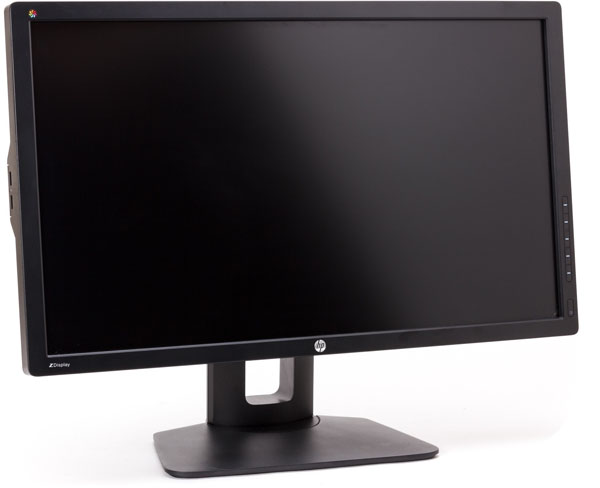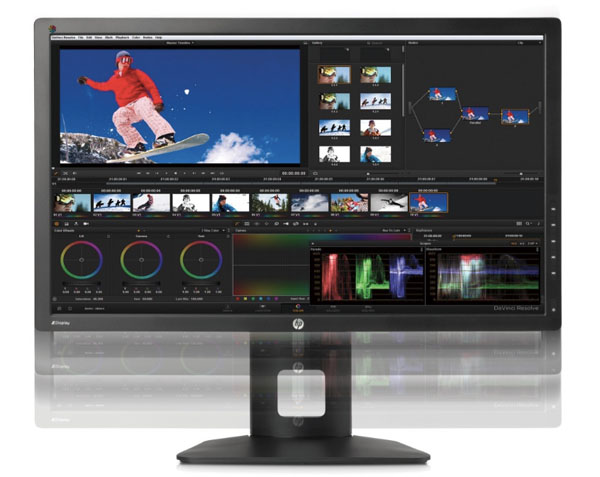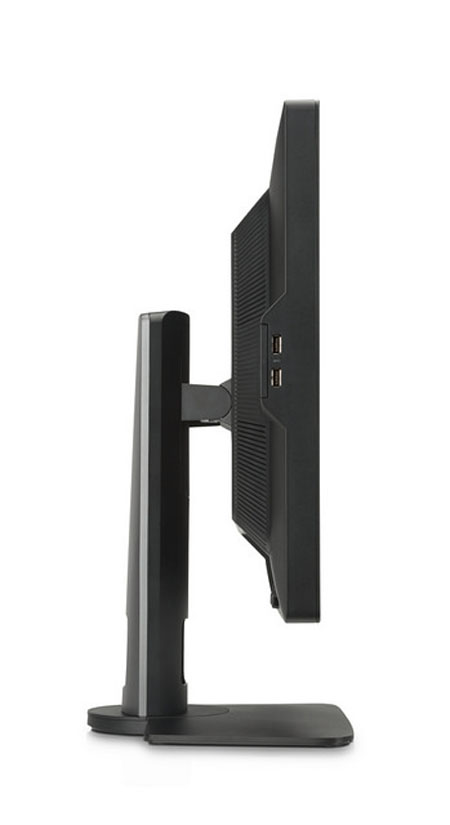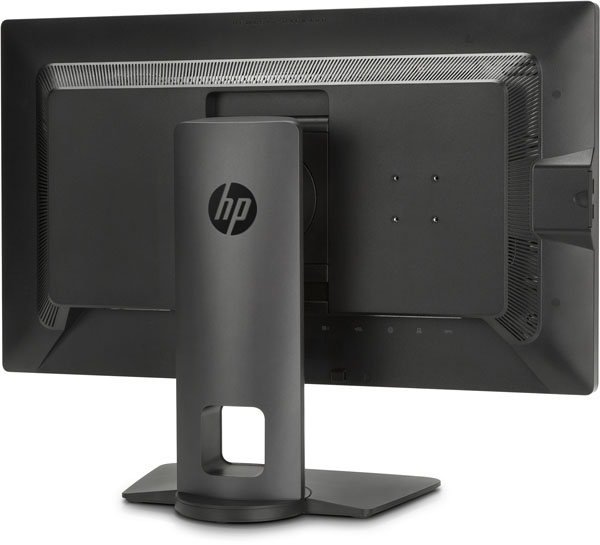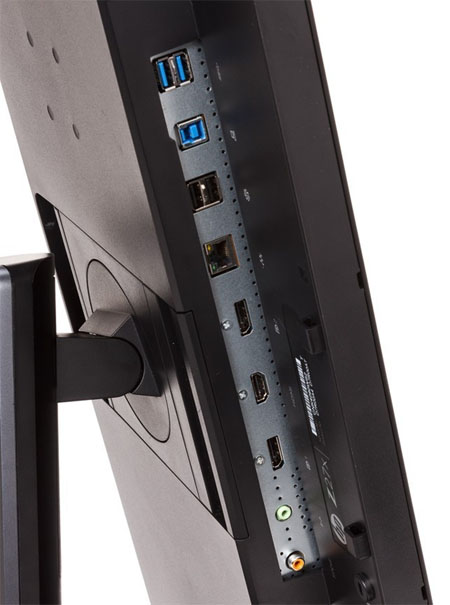HP Z27x Dreamcolor Professional Display Review
HP's new Z27x DreamColor supports all the important color gamuts and carries some distinctly unique features. This screen simply blows us away.
Why you can trust Tom's Hardware
Packaging, Physical Layout And Accessories
The Z27x comes packed sturdily in a large double-corrugate carton. It’s so deep you might think two monitors are inside. The bundle covers every possible connection option. In addition to HDMI, there are two DisplayPort cables (one has a mini-plug) and USB 3.0 Standard A-to-B. An IEC power cord feeds current to the internal power supply. You also get a complete inspection report that covers dead pixels, screen uniformity, and several other quality control parameters. It’s a professional product for sure, and HP checks each one carefully before it goes out the door.
The base and upright are already assembled, so all you have to do is snap it onto the back of the panel.
Product 360
From the front, the Z27x is all business. Its anti-glare layer is of light density, so users in brightly-lit workspaces may want to consider purchasing the optional hood for critical work. Image clarity is among the best we’ve seen. Bezel buttons are located in the lower-right, and are mechanical rather than touch-sensitive. They can be lit either white or red, and feel high-end in operation. By default, they fade to black after the OSD leaves the screen.
The Z27x can be positioned easily with a full set of ergonomic adjustments. The height range is 4.75 inches and you can tilt the panel -5 to 20 degrees. Swivel covers 45 degrees in either direction and there is a portrait mode that automatically rotates the image.
The monitor isn’t terribly slim, but that’s to ensure proper ventilation of the internals (which are substantial). The USB ports are version 3.0-compliant, and there are two more on the input panel. Just behind the ports is a little pull-out card that shows the serial number and other pertinent information, saving you from look behind the panel when calling tech support.
To use the 100 mm VESA mount, simply unsnap the upright. HP includes an adapter plate that allows tool-free installation to a variety of arms and brackets. The four holes next to the upright span 40 mm and facilitate attachment of additional accessories.
The input panel is all-digital, save the analog audio output that can drive either speakers or headphones. You’ll also notice the S/PDIF digital audio output, which is something we haven’t seen outside of an HDTV. Again, video inputs include one HDMI and two DisplayPort 1.2. There's a USB 3.0 upstream port and two downstream connections as well. The USB 2.0 ports are intended for a calibration instrument. When a supported one is detected, the internal calibration routine opens automatically. Finally, you get an Ethernet jack for control and administration purposes. It works both ways, allowing you to poll the Z27x for information like screen hours or calibration status. Settings and firmware updates can be sent to connected displays as well.
Get Tom's Hardware's best news and in-depth reviews, straight to your inbox.
Signal Handling
The Z27x has some unique capabilities when it comes to signal handling. Since it is primarily designed as a mastering monitor for broadcast content, it accepts all resolutions currently in use by the film and television industry. This includes resolutions larger than its native 2560x1440.
Most Hollywood movies are mastered first in the Digital Cinema Initiative realm, meaning a resolution of at least 2048x1080 spanning as high as 4096x2160. The Z27x can accept both of these and everything in between. And it can crop the screen to 1.85:1, 1.89:1, and 2.39:1 aspect ratios. As if that weren’t enough, it can handle 24p, 48p, and 60p frame rates (though at 4096x2160, it’s limited to 24p). And all of this can be done over HDMI if your graphics card is compatible.
The way it handles 4K resolutions is intuitive. You can choose to scale the image so all of it fits on the screen. Or, you can show a specific quadrant of the image (or its center zone). Finally, you can scroll around the image using on-screen navigation arrows. In this mode, it’s mapped pixel-for-pixel, so you’re seeing the content with no scaling or processing.
Current page: Packaging, Physical Layout And Accessories
Prev Page HP Z27x DreamColor Professional Display Review Next Page OSD Setup And Calibration Of The HP Z27x
Christian Eberle is a Contributing Editor for Tom's Hardware US. He's a veteran reviewer of A/V equipment, specializing in monitors. Christian began his obsession with tech when he built his first PC in 1991, a 286 running DOS 3.0 at a blazing 12MHz. In 2006, he undertook training from the Imaging Science Foundation in video calibration and testing and thus started a passion for precise imaging that persists to this day. He is also a professional musician with a degree from the New England Conservatory as a classical bassoonist which he used to good effect as a performer with the West Point Army Band from 1987 to 2013. He enjoys watching movies and listening to high-end audio in his custom-built home theater and can be seen riding trails near his home on a race-ready ICE VTX recumbent trike. Christian enjoys the endless summer in Florida where he lives with his wife and Chihuahua and plays with orchestras around the state.
-
DoDidDont I have 3x Z24x, very impressed with them so far for compositing and 3d work. Would have gone with 3x Z27x but simply don’t have the desk space or room for a bigger desk. My only worry is if they have the same problem as the older ZR24w’s they replaced, in that the whites go yellowish and make greys have a tint of brown after only one or two years of use. Always had a dark grey desktop, and in 3ds max everything is set to Dark GUI, and always been careful not to leave monitors on for long periods with the same image so no idea why the older ZR24w’s go yellowish after a while. Hopefully this problem has been fixed in the new line-up. But at the Mo, highly recommend these monitors, amazing quality for the price if you are into DCC.Reply -
laststop311 .29 is not a good black level really. Hopefully oleds will displace the need for these monitors soon, only a matter of timeReply -
somebodyspecial hopefully 1600p will displace 1440p soon ;) I'm tired of scrolling up/down so much on web pages. Gaming doesn't get any better wide either, and if I want that I'll use more than one monitor to get the best of both worlds (taller for the web, and wider for games if desired).Reply -
laststop311 Reply14215918 said:hopefully 1600p will displace 1440p soon ;) I'm tired of scrolling up/down so much on web pages. Gaming doesn't get any better wide either, and if I want that I'll use more than one monitor to get the best of both worlds (taller for the web, and wider for games if desired).
Agree 100% I had a 24" 1920x1080 Cheapo TN monitor and then I found a Dell u3014 on craigslist and jewed the guy down to 575 for it. The bezel was a little scuffed up but the screen was flawless was a hell of a deal and man once you are used to 16:10 you cant go back to 16:9 it feels claustrophobic.
I am not a graphics professional though. But I fear since 16:10 is more a professional monitor we will never see a gaming monitor with 120hz and g sync in 16:10. I just can't bring myself to downgrade to a 27" asus rog swift even tho i really could use the gaming features. I'm probably just going to hold onto this dell until 120hz 3840x2160 rog swift type monitor is released at 30-34 inches. I don't think there is much hope in 16:10 4k monitors, never seen one yet 3840 x 2400 i believe.
-
Draven35 When I was at HP in Fort Collins for the new Z Workstation launch, I had an opportunity (several opportunities, really) to chat with Greg Staten, the HP DreamColor Solution Architect. He's really enthusiastic about his work and was really excited that this review was coming!Reply -
rajubaju Complaints about lack of CMS in OSD... I couldn't agree with them more. Totally unacceptable... Especially when you know; z24x provides that possibility (like every other, wide gamut, monitor on the market; nec pa272w, dell u2713h, asus pa279q, vp2772, lg 27ea83-D etc.) In the z24x manual, we can read: "the User (User Preset) adjustable color settings for customers who do not have calibration equipment". What is the difference? with z27x - price i guess - you pay more, you get less! ;) I understand that now, when I buy z27x, I must buy a colorimeter (HP ofc)... even if I do not need ideal color accuracy... and i only want adjust monitor (RGB primaries) for my preferences. Not a chance! I hope that Greg Staten read this and add User preset, like in z24x, to Z27x... About saturation, 6 color adjustment, etc. I don't even dream; It would be a miracle! ;)Reply
